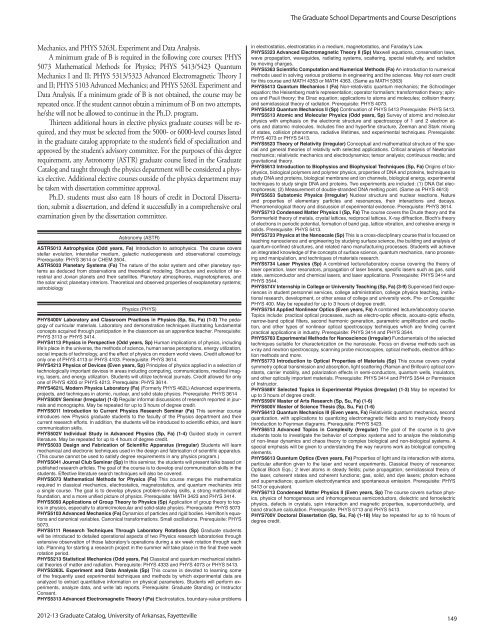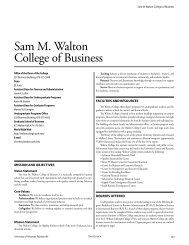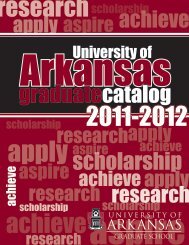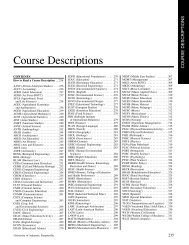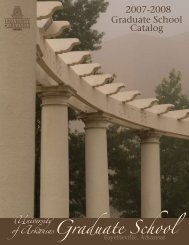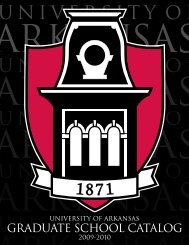PDF of the Graduate Catalog of Studies (2.6 MB)
PDF of the Graduate Catalog of Studies (2.6 MB)
PDF of the Graduate Catalog of Studies (2.6 MB)
Create successful ePaper yourself
Turn your PDF publications into a flip-book with our unique Google optimized e-Paper software.
The <strong>Graduate</strong> School Departments and Course Descriptions<br />
Mechanics, and PHYS 5263L Experiment and Data Analysis.<br />
A minimum grade <strong>of</strong> B is required in <strong>the</strong> following core courses: PHYS<br />
5073 Ma<strong>the</strong>matical Methods for Physics; PHYS 5413/5423 Quantum<br />
Mechanics I and II; PHYS 5313/5323 Advanced Electromagnetic Theory I<br />
and II; PHYS 5103 Advanced Mechanics; and PHYS 5263L Experiment and<br />
Data Analysis. If a minimum grade <strong>of</strong> B is not obtained, <strong>the</strong> course may be<br />
repeated once. If <strong>the</strong> student cannot obtain a minimum <strong>of</strong> B on two attempts,<br />
he/she will not be allowed to continue in <strong>the</strong> Ph.D. program.<br />
Thirteen additional hours in elective physics graduate courses will be required,<br />
and <strong>the</strong>y must be selected from <strong>the</strong> 5000- or 6000-level courses listed<br />
in <strong>the</strong> graduate catalog appropriate to <strong>the</strong> student’s field <strong>of</strong> specialization and<br />
approved by <strong>the</strong> student’s advisory committee. For <strong>the</strong> purposes <strong>of</strong> this degree<br />
requirement, any Astronomy (ASTR) graduate course listed in <strong>the</strong> <strong>Graduate</strong><br />
<strong>Catalog</strong> and taught through <strong>the</strong> physics department will be considered a physics<br />
elective. Additional elective courses outside <strong>of</strong> <strong>the</strong> physics department may<br />
be taken with dissertation committee approval.<br />
Ph.D. students must also earn 18 hours <strong>of</strong> credit in Doctoral Dissertation,<br />
submit a dissertation, and defend it successfully in a comprehensive oral<br />
examination given by <strong>the</strong> dissertation committee.<br />
Astronomy (ASTR)<br />
ASTR5013 Astrophysics (Odd years, Fa) Introduction to astrophysics. The course covers<br />
stellar evolution, interstellar medium, galactic nucleogenesis and observational cosmology.<br />
Prerequisite: PHYS 3614 or CHEM 3504.<br />
ASTR5033 Planetary Systems (Fa) The nature <strong>of</strong> <strong>the</strong> solar system and o<strong>the</strong>r planetary systems<br />
as deduced from observations and <strong>the</strong>oretical modeling. Structure and evolution <strong>of</strong> terrestrial<br />
and Jovian planets and <strong>the</strong>ir satellites. Planetary atmospheres, magnetospheres, and<br />
<strong>the</strong> solar wind; planetary interiors. Theoretical and observed properties <strong>of</strong> exoplanetary systems;<br />
astrobiology<br />
Physics (PHYS)<br />
PHYS400V Laboratory and Classroom Practices in Physics (Sp, Su, Fa) (1-3) The pedagogy<br />
<strong>of</strong> curricular materials. Laboratory and demonstration techniques illustrating fundamental<br />
concepts acquired through participation in <strong>the</strong> classroom as an apprentice teacher. Prerequisite:<br />
PHYS 3113 or PHYS 3414.<br />
PHYS4113 Physics in Perspective (Odd years, Sp) Human implications <strong>of</strong> physics, including<br />
life’s place in <strong>the</strong> universe, <strong>the</strong> methods <strong>of</strong> science, human sense perceptions, energy utilization,<br />
social impacts <strong>of</strong> technology, and <strong>the</strong> effect <strong>of</strong> physics on modern world views. Credit allowed for<br />
only one <strong>of</strong> PHYS 4113 or PHYS 4103. Prerequisite: PHYS 3614.<br />
PHYS4213 Physics <strong>of</strong> Devices (Even years, Sp) Principles <strong>of</strong> physics applied in a selection <strong>of</strong><br />
technologically important devices in areas including computing, communications, medical imaging,<br />
lasers, and energy utilization. Students will utilize technical journals. Credit allowed for only<br />
one <strong>of</strong> PHYS 4203 or PHYS 4213. Prerequisite: PHYS 3614.<br />
PHYS4621L Modern Physics Laboratory (Fa) (Formerly PHYS 462L) Advanced experiments,<br />
projects, and techniques in atomic, nuclear, and solid state physics. Prerequisite: PHYS 3614<br />
PHYS500V Seminar (Irregular) (1-3) Regular informal discussions <strong>of</strong> research reported in journals<br />
and monographs. May be repeated for up to 3 hours <strong>of</strong> degree credit.<br />
PHYS5011 Introduction to Current Physics Research Seminar (Fa) This seminar course<br />
introduces new Physics graduate students to <strong>the</strong> faculty <strong>of</strong> <strong>the</strong> Physics department and <strong>the</strong>ir<br />
current research efforts. In addition, <strong>the</strong> students will be introduced to scientific ethics, and learn<br />
communication skills.<br />
PHYS502V Individual Study in Advanced Physics (Sp, Fa) (1-4) Guided study in current<br />
literature. May be repeated for up to 4 hours <strong>of</strong> degree credit.<br />
PHYS5033 Design and Fabrication <strong>of</strong> Scientific Apparatus (Irregular) Students will learn<br />
mechanical and electronic techniques used in <strong>the</strong> design and fabrication <strong>of</strong> scientific apparatus.<br />
(This course cannot be used to satisfy degree requirements in any physics program.)<br />
PHYS5041 Journal Club Seminar (Sp) In this seminar, <strong>the</strong> students will present talks based on<br />
published research articles. The goal <strong>of</strong> <strong>the</strong> course is to develop oral communication skills in <strong>the</strong><br />
students. Effective literature search techniques will also be covered.<br />
PHYS5073 Ma<strong>the</strong>matical Methods for Physics (Fa) This course merges <strong>the</strong> ma<strong>the</strong>matics<br />
required in classical mechanics, electrostatics, magnetostatics, and quantum mechanics into<br />
a single course. The goal is to develop physics problem-solving skills, a strong ma<strong>the</strong>matical<br />
foundation, and a more unified picture <strong>of</strong> physics. Prerequisite: MATH 3423 and PHYS 3414.<br />
PHYS5093 Applications <strong>of</strong> Group Theory to Physics (Sp) Application <strong>of</strong> group <strong>the</strong>ory to topics<br />
in physics, especially to atomic/molecular and solid-state physics. Prerequisite: PHYS 5073<br />
PHYS5103 Advanced Mechanics (Fa) Dynamics <strong>of</strong> particles and rigid bodies. Hamilton’s equations<br />
and canonical variables. Canonical transformations. Small oscillations. Prerequisite: PHYS<br />
5073.<br />
PHYS5111 Research Techniques Through Laboratory Rotations (Sp) <strong>Graduate</strong> students<br />
will be introduced to detailed operational aspects <strong>of</strong> two Physics research laboratories through<br />
extensive observation <strong>of</strong> those laboratory’s operations during a six week rotation through each<br />
lab. Planning for starting a research project in <strong>the</strong> summer will take place in <strong>the</strong> final three week<br />
rotation period.<br />
PHYS5213 Statistical Mechanics (Odd years, Fa) Classical and quantum mechanical statistical<br />
<strong>the</strong>ories <strong>of</strong> matter and radiation. Prerequisite: PHYS 4333 and PHYS 4073 or PHYS 5413.<br />
PHYS5263L Experiment and Data Analysis (Sp) This course is devoted to learning some<br />
<strong>of</strong> <strong>the</strong> frequently used experimental techniques and methods by which experimental data are<br />
analyzed to extract quantitative information on physical parameters. Students will perform experiments,<br />
analyze data, and write lab reports. Prerequisite: <strong>Graduate</strong> Standing or Instructor<br />
Consent.<br />
PHYS5313 Advanced Electromagnetic Theory I (Fa) Electrostatics, boundary-value problems<br />
2012-13 <strong>Graduate</strong> <strong>Catalog</strong>, University <strong>of</strong> Arkansas, Fayetteville<br />
in electrostatics, electrostatics in a medium, magnetostatics, and Faraday’s Law.<br />
PHYS5323 Advanced Electromagnetic Theory II (Sp) Maxwell equations, conservation laws,<br />
wave propagation, waveguides, radiating systems, scattering, special relativity, and radiation<br />
by moving charges.<br />
PHYS5363 Scientific Computation and Numerical Methods (Fa) An introduction to numerical<br />
methods used in solving various problems in engineering and <strong>the</strong> sciences. May not earn credit<br />
for this course and MATH 4353 or MATH 4363. (Same as MATH 5363)<br />
PHYS5413 Quantum Mechanics I (Fa) Non-relativistic quantum mechanics; <strong>the</strong> Schrodinger<br />
equation; <strong>the</strong> Heisenberg matrix representation; operator formalism; transformation <strong>the</strong>ory; spinors<br />
and Pauli <strong>the</strong>ory; <strong>the</strong> Dirac equation; applications to atoms and molecules; collision <strong>the</strong>ory;<br />
and semiclassical <strong>the</strong>ory <strong>of</strong> radiation. Prerequisite: PHYS 4073.<br />
PHYS5423 Quantum Mechanics II (Sp) Continuation <strong>of</strong> PHYS 5413 Prerequisite: PHYS 5413.<br />
PHYS5513 Atomic and Molecular Physics (Odd years, Sp) Survey <strong>of</strong> atomic and molecular<br />
physics with emphasis on <strong>the</strong> electronic structure and spectroscopy <strong>of</strong> 1 and 2 electron atoms<br />
and diatomic molecules. Includes fine and hyperfine structure, Zeeman and Stark mixing<br />
<strong>of</strong> states, collision phenomena, radiative lifetimes, and experimental techniques. Prerequisite:<br />
PHYS 4073 or PHYS 5413.<br />
PHYS5523 Theory <strong>of</strong> Relativity (Irregular) Conceptual and ma<strong>the</strong>matical structure <strong>of</strong> <strong>the</strong> special<br />
and general <strong>the</strong>ories <strong>of</strong> relativity with selected applications. Critical analysis <strong>of</strong> Newtonian<br />
mechanics; relativistic mechanics and electrodynamics; tensor analysis; continuous media; and<br />
gravitational <strong>the</strong>ory.<br />
PHYS5613 Introduction to Biophysics and Biophysical Techniques (Sp, Fa) Origins <strong>of</strong> biophysics,<br />
biological polymers and polymer physics, properties <strong>of</strong> DNA and proteins, techniques to<br />
study DNA and proteins, biological membrane and ion channels, biological energy, experimental<br />
techniques to study single DNA and proteins. Two experiments are included: (1) DNA Gel electrophoresis;<br />
(2) Measurement <strong>of</strong> double-stranded DNA melting point. (Same as PHYS 4613)<br />
PHYS5653 Subatomic Physics (Irregular) Nuclear structure and nuclear reactions. Nature<br />
and properties <strong>of</strong> elementary particles and resonances, <strong>the</strong>ir interactions and decays.<br />
Phenomenological <strong>the</strong>ory and discussion <strong>of</strong> experimental evidence. Prerequisite: PHYS 3614.<br />
PHYS5713 Condensed Matter Physics I (Sp, Fa) The course covers <strong>the</strong> Drude <strong>the</strong>ory and <strong>the</strong><br />
Sommerfeld <strong>the</strong>ory <strong>of</strong> metals, crystal lattices, reciprocal lattices, X-ray diffraction, Bloch’s <strong>the</strong>ory<br />
<strong>of</strong> electrons in periodic potential, formation <strong>of</strong> band gap, lattice vibration, and cohesive energy in<br />
solids. Prerequisite: PHYS 5413.<br />
PHYS5723 Physics at <strong>the</strong> Nanoscale (Sp) This is a cross-disciplinary course that is focused on<br />
teaching nanoscience and engineering by studying surface science, <strong>the</strong> building and analysis <strong>of</strong><br />
quantum-confined structures, and related nano manufacturing processes. Students will achieve<br />
an integrated knowledge <strong>of</strong> <strong>the</strong> concepts <strong>of</strong> surface science, quantum mechanics, nano processing<br />
and manipulation, and techniques <strong>of</strong> materials research.<br />
PHYS5734 Laser Physics (Sp) A combined lecture/laboratory course covering <strong>the</strong> <strong>the</strong>ory <strong>of</strong><br />
laser operation, laser resonators, propagation <strong>of</strong> laser beams, specific lasers such as gas, solid<br />
state, semiconductor and chemical lasers, and laser applications. Prerequisite: PHYS 3414 and<br />
PHYS 3544.<br />
PHYS574V Internship in College or University Teaching (Sp, Fa) (3-9) Supervised field experiences<br />
in student personnel services, college administration, college physics teaching, institutional<br />
research, development, or o<strong>the</strong>r areas <strong>of</strong> college and university work. Pre- or Corequisite:<br />
PHYS 400. May be repeated for up to 3 hours <strong>of</strong> degree credit.<br />
PHYS5754 Applied Nonlinear Optics (Even years, Fa) A combined lecture/laboratory course.<br />
Topics include: practical optical processes, such as electro-optic effects, acousto-optic effects,<br />
narrow-band optical filters, second harmonic generation, parametric amplification and oscillation,<br />
and o<strong>the</strong>r types <strong>of</strong> nonlinear optical spectroscopy techniques which are finding current<br />
practical applications in industry. Prerequisite: PHYS 3414 and PHYS 3544.<br />
PHYS5763 Experimental Methods for Nanoscience (Irregular) Fundamentals <strong>of</strong> <strong>the</strong> selected<br />
techniques suitable for characterization on <strong>the</strong> nanoscale. Focus on diverse methods such as<br />
x-ray and neutron spectroscopy, scanning probe microscopies, optical methods, electron diffraction<br />
methods and more.<br />
PHYS5773 Introduction to Optical Properties <strong>of</strong> Materials (Sp) This course covers crystal<br />
symmetry optical transmission and absorption, light scattering (Raman and Brillouin) optical constants,<br />
carrier mobility, and polarization effects in semi-conductors, quantum wells, insulators,<br />
and o<strong>the</strong>r optically important materials. Prerequisite: PHYS 3414 and PHYS 3544 or Permission<br />
<strong>of</strong> Instructor.<br />
PHYS588V Selected Topics in Experimental Physics (Irregular) (1-3) May be repeated for<br />
up to 3 hours <strong>of</strong> degree credit.<br />
PHYS590V Master <strong>of</strong> Arts Research (Sp, Su, Fa) (1-6)<br />
PHYS600V Master <strong>of</strong> Science Thesis (Sp, Su, Fa) (1-6)<br />
PHYS6413 Quantum Mechanics III (Even years, Fa) Relativistic quantum mechanics, second<br />
quantization, with applications to quantizing electromagnetic fields and to many-body <strong>the</strong>ory.<br />
Introduction to Feynman diagrams. Prerequisite: PHYS 5423.<br />
PHYS6513 Advanced Topics in Complexity (Irregular) The goal <strong>of</strong> <strong>the</strong> course is to give<br />
students tools to investigate <strong>the</strong> behavior <strong>of</strong> complex systems and to analyze <strong>the</strong> relationship<br />
<strong>of</strong> non-linear dynamics and chaos <strong>the</strong>ory to complex biological and non-biological systems. A<br />
special emphasis will be given to understanding <strong>the</strong> way neurons work as biological computing<br />
elements.<br />
PHYS6613 Quantum Optics (Even years, Fa) Properties <strong>of</strong> light and its interaction with atoms,<br />
particular attention given to <strong>the</strong> laser and recent experiments. Classical <strong>the</strong>ory <strong>of</strong> resonance;<br />
Optical Bloch Eqs.; 2 level atoms in steady fields; pulse propagation; semiclassical <strong>the</strong>ory <strong>of</strong><br />
<strong>the</strong> laser, coherent states and coherent functions; gas, solid, and dye lasers; photon echoes<br />
and superradiance; quantum electrodynamics and spontaneous emission. Prerequisite: PHYS<br />
5413 or equivalent.<br />
PHYS6713 Condensed Matter Physics II (Even years, Sp) The course covers surface physics,<br />
physics <strong>of</strong> homogeneous and inhomogeneous semiconductors, dielectric and ferroelectric<br />
physics, defects in crystals, spin interaction and magnetic properties, superconductivity, and<br />
band structure calculation. Prerequisite: PHYS 5713 and PHYS 5413.<br />
PHYS700V Doctoral Dissertation (Sp, Su, Fa) (1-18) May be repeated for up to 18 hours <strong>of</strong><br />
degree credit.<br />
149


